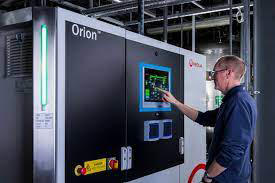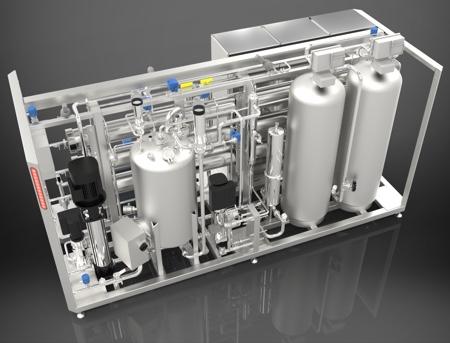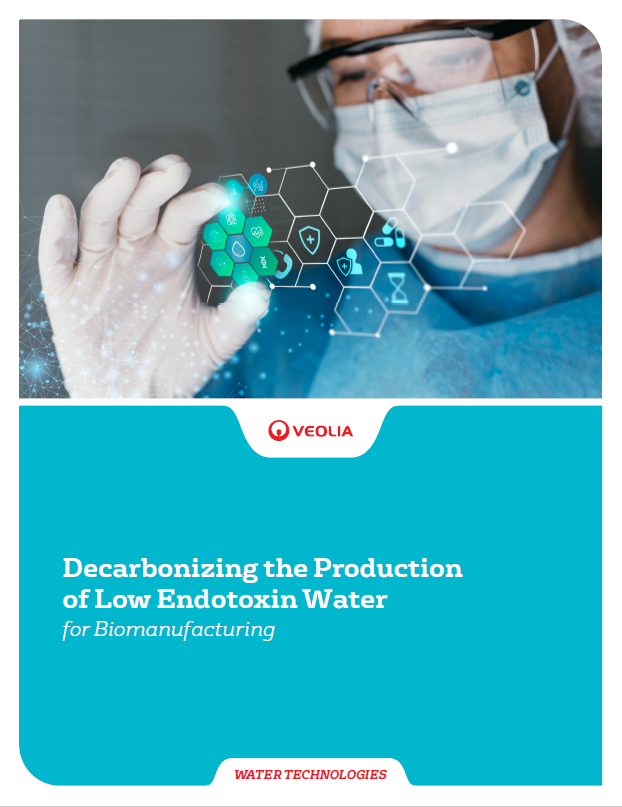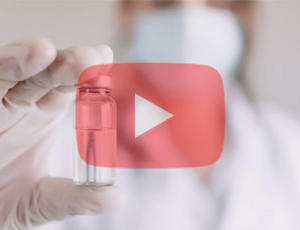Harmonized global regulation to produce water for injection (WFI) using membranes has created an opportunity to generate significant operational savings and sustainability advantages for pharmaceutical and biotechnology product manufacturers.
For many years, distillation has been the only choice to produce WFI. This traditional “hot” process involves a phase change of water into steam to remove bacteria and endotoxins before condensing the steam back into liquid. High operating temperatures ensure optimal water purification with low contamination risks. Though this is a highly trusted process, there are some significant downsides, such as high energy intensity, volatile fuel costs, increased carbon footprint, and large system footprints.
A New Era for Safer, Cleaner, Smaller WFI Generation is Here
For decades, the USP (United States Pharmacopeia) has permitted the use of membrane-based systems, also known as “Cold WFI;” however, many still opted for distillation because the Europan Pharmacopeia (EP) specified distillation as the only method to produce WFI. This strong-armed many companies which produce pharmaceuticals with international distribution to only use distillation through multiple-effect or vacuum compression technologies for WFI production.
It wasn’t until 2017 that the EP revised its guidelines to allow for this alternative, effectively granting manufacturers the choice to utlize alternative methods to produce WFI. The guidelines state that water for injection can be produced using alternative technologies, as long as the quality is equivalent to distillation. Systems that can meet this requirement include membrane systems such as reverse osmosis (RO) combined with continuous electrodeionization (CEDI) to meet the required conductivity specification. Then instead of evaporating the water with a distillation unit, an ultrafiltration (UF) membrane-system is used to remove any biofilm growth or endotoxins.
This specification change has created a new era for pharmaceutical and biotech companies, giving them a choice of the type of system to produce WFI. And companies making the switch to cold WFI are able to unlock substantial operational improvements, sustainability enhancements, and energy savings.
Sustainability Resource
Compared to small-molecule drugs, therapeutic proteins produced by cell culture or microbial fermentation can use 10 to 100 times more water. This guide will discuss the importance of low endotoxin water and how energy-efficient technologies can create a pathway to decarbonization.

What is Cold WFI?
So what is “Cold WFI.” Is it actually cold? Not exactly; “Cold WFI” is a descriptor for a purification process to produce WFI by means other than distillation. However, Cold WFI isn’t actually cold but operates at ambient temperatures. On the other hand, distillation, or “Hot WFI” operates at very high temperatures to convert the purified water feed into steam, then condense the steam into sterile water.
Cold WFI systems have many of the same pre-treatment steps as Hot WFI processes. Both hot and Cold WFI systems often take softened, dechlorinated feedwater and treat it with reverse osmosis and electrodeionization. But, the key difference between the two types of WFI systems is that Cold WFI systems utilize a second membrane barrier, such as low-pressure ultrafiltration (UF), to ensure microbiological quality in place of energy-intensive distillation processes.
The Advantages of “Cold WFI”
Now that biopharmaceutical companies have a choice when it comes to the type of high purity water treatment process to produce safe, compliant WFI, it is important to consider both systems, the potential risks, and the lifecycle costs. Both systems are very capable of producing water for injection; however, it is important to note that the Cold WFI process can lead to measurable advantages through low-cost microbiological control interventions that mitigate any contamination risk and avoid the higher capital and operating expenses of evaporating WFI, particularly when most of its uses are specified at low temperatures.
Below are some of the key advantages that Cold WFI systems can provide.
Significantly Lower OPEX Costs
One of the largest advantages Cold WFI systems have over distillation is related to operational costs. Distillation is extremely energy-intensive and requires large amounts of steam, or electricity, to facilitate the liquid to gas phase change. For many systems, a required cooling stage is also required to lower the temperature of the distilled water to the required distribution temperature. Because Cold WFI systems operate at ambient temperature, their energy requirements pale in comparison to distillation. Depending on the type of distillation process, the total OPEX savings of Cold WFI systems can reach 70% or more.
Lower CAPEX for Cold WFI Systems
Another core benefit is a lower capital cost when compared to distillation. Hot WFI systems require a higher level of pretreatment before the distillation step, which correlates to additional equipment and cost. Cold WFI converts any source of softened, dechlorinated drinking feed water into ultrapure WFI quality thanks to a double membrane barrier integrating reverse osmosis, chemical-free continuous electrodeionization, and ultrafiltration in a configuration that is simpler and lower in CAPEX cost. When comparing the two systems, Cold WFI systems can save manufacturers up to 43% when compared to an equivalent Hot WFI system.
Reduced Cabon Footprint and Increased Sustainability
Sustainability is also a critical advantage of Cold WFI systems. Many corporations have aggressive sustainability initiatives that include reductions in waste, carbon, and water footprints. These initiatives are forcing engineers to creatively uncover additional opportunities to ensure all aspects of manufacturing facilities are supporting these environmental targets. Because of its outsized contribution to facility carbon emissions, Cold WFI is a key area that can help companies meet these sustainability goals. Up to 80% of the current WFI demand is generated through heat, which is produced mainly through fossil fuels.
By utilizing a Cold WFI method, the need for a constant supply of steam, or heat, to produce compendial water is removed, lowering fossil energy use and driving a more environmentally sustainable operation of clean water utilities. Also, with Cold WFI systems being “all-electric,” these systems are primed for a fully decarbonized operation as biomanufacturing facilities are increasingly powered by on-site renewable energy sources, such as solar, wind, or waste-to-energy.
Compact Footprint
One last benefit is physical footprint. Where space is limited, a membrane system may be preferred as they typically have a smaller footprint. This allows the system to be more easily integrated in a retrofit or facility upgrade when compared to distillation.

Managing the Risks of Cold WFI

It is important to note that no system is without risk. A small risk with a Cold WFI system is the possibility of biofilm or bacterial growth. Biofilm growth may occur as a result of the inherent lower temperatures of a Cold WFI system. However, these risks can be easily managed through frequent hot water sanitization within the RO/CEDI/UF system. This sanitization step is highly effective at preventing and removing any high levels of biofilm within the system without the use of chemicals.
It is believed that there is a larger risk of relying on legacy technology that is not supporting cost-competitive operations and net-zero goals while exposing the industry to energy insecurity, volatile fossil fuel prices, and the backlash of stakeholders questioning the seriousness of the industry’s ambitious climate agenda. Time for engineers and utility managers to break with tradition and accelerate the electrification and transformational changes necessary to position their companies for a future of more efficient and resilient WFI operations.
Choosing the Right System
Both cold and Hot WFI systems will produce water that meets the specified standard for WFI. Therefore clean water utility managers need to consider the operational requirements, existing equipment and systems, available space, corporate sustainability initiatives, and of course CAPEX and OPEX budgets. Regardless, the ability to have options on the type of system to produce water for injection empowers pharmaceutical companies to make the best choice for their organization.
Need help navigating the best option to produce Water for Injection?
Our experts are able to help you explore the available technologies and evaluate the best option for your facility.




